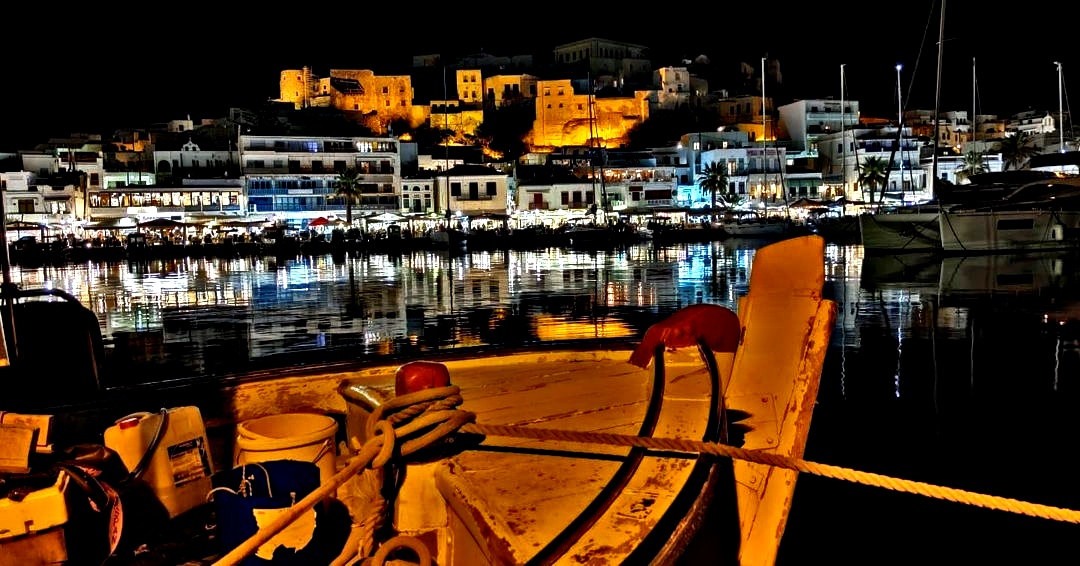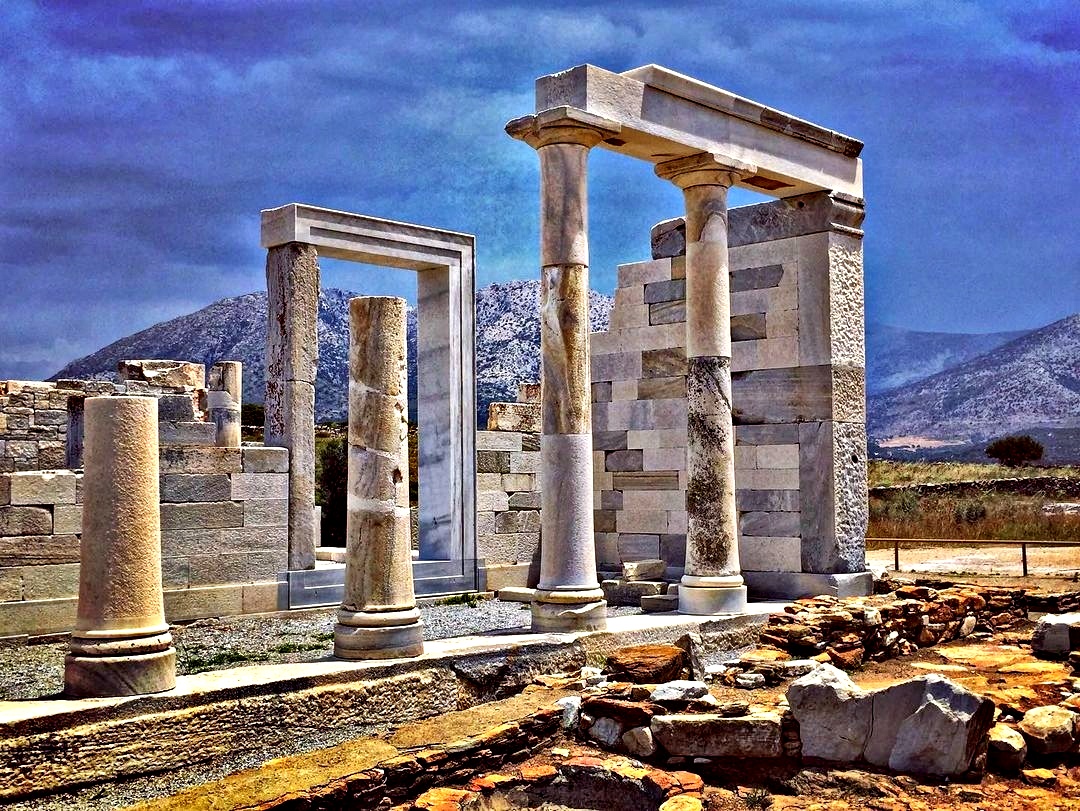Sightseeing
The archeological museum: All findings from excavations are kept in the archaeological museum, proof of the uninterrupted cultural presence in Naxos from pre-historic times until the end of the ancient times. The museum is housed in the building of the former Commercial School in the area of the Castle.
Grotta’s archaeological site: Excavations made under Metropolis square have revealed some remains of the Mycenaean city of Naxos (1600 – 1100 B.C). The place has been landscaped and it is open to the public.
“Portara”: Naxos’ trademark: Portara can be seen from afar as ships approach the island of Naxos, standing on the northern side of the port. This monument is a gigantic gate, which remains from a temple that was dedicated to Apollo. It was built during the 6th century B.C, when Naxos used to be a commercial and cultural centre.
The castle: An impressive monument which was built during the long Venetian rule (1204-1537); it is located on a hill which is the natural acropolis of Hora. A medieval town in the heart of the Aegean still in its original form, inhabited continuously since 1207. The external walls of the peripheral houses shape the wall of the Castle, which has only three entrance gates.
Kouros (Flerio): At Flerio, near the village of Melanes, there is a half finished male statue, belonging to the 7th century B.C., 6.4 metres tall, which was found in an olive grove.
Kouros (Apollonas): Near the village Apollonas and near to the entrance of an ancient mine, there is a half finished “Kouros” (male statue) lying on the ground, which has never been moved from this spot. The statue is 10.45 metres high and is dated at the beginning of the 6th century B.C.
The church of Protothroni Virgin: The church of Protothroni Virgin (9th-10th cent.) in the village Halki is the biggest Byzantine church in Naxos, with important wall paintings. Mass has been held here since Early Christian times until today
Experience
If paradise was on Earth, it would be here” wrote the great philosopher , Nikos Kazantzakis.
Indeed, Naxos was the favorite island of the gods of ancient Greeks.
Naxos is not a typical Cycladic island,it has Venetian castles, medieval walls, stone built churches and monasteries, soaked mountain volumes, sandy beaches, picturesque villages, museums, archaeological sites and stunning cuisine.
God of joy and prosperity, Dionysus was the ancient god of Naxos.
Naxos will offer you a Dionysian experience of joy. Naxos with the beautiful nature , with a majestic Aegean and multi color scenery, is an irresistibly attractive destination.
One thing is certain, in Naxos you will not be bored !!!
ultural events are organized all summer in the restored tower of Bazaios. (www.bazeostower.gr)
WHAT TO SEE
Put on your program an excursion to:
- The Ancient Sanctuary of Apollo and Dimitras at Gyroula Sagri (daily, except Mondays, 08: 30-15: 00).
- The Sanctuary of Dionysus in the Yria (daily except Monday, 08: 30-15: 00, 22850 42325, 22850 22725)
- The Apollo Kouro in the village of Apollonas, is a huge impressive semi-finished kouro in the ancient quarry of the area.
- And do not forget to climb up to the Temple of Apollo, wich is the trademark of Naxos, the well-known Portara in the port of the island.
The island has seven museums of particular interest, such as:
- the Archaeological Museum, which is housed in the building of the Commercial School in Chora, exhibits dating back to the Neolithic period until the Early Christian period (daily, except Monday, 08: 30-15: 00 22850 22725) .
- The Byzantine Museum, housed in one of the most imposing buildings of Chora Castle, the famous tower of Krispi, hosts a very remarkable exhibition of Byzantine sculpture from Naxos and the Cyclades from the 7th to the 12th century (daily except Sunday , 10: 00-14: 00, 210 3218075).
- The Geological Museum in Apeiranthos, with a special collection of minerals and minerals from Naxos and the South Aegean since 1964 (July, 10: 30-19: 30 & August 10: 30-21: 00, 22850 61725).
- The Venetian Museum in Chora at the Della Rocca-Barozzi tower, with furniture and utilitarian items of the time (daily from 10: 00-15: 00 & 19: 00-22: 00, 22850-28377).
- The On-site Archaeological Museum, a unique museum of its kind, where visitors can admire the ancient remains of the Mycenaean city of Grotta, where they were found (daily, except Mondays, 08: 30-15: 00, 22850 22725, in the square Metropolis of Chora).
- The Folklore Museum, in the central square of Apeiranthos with more than 1,200 exhibits of folk art (July 10: 30-19: 30 & August 10: 30-21: 00, 22850 61725).Traditional olive presses
- of Boulamatsades and Church; olive press at Livadaki neighborhood in the settlement of Koronos (22850 51457, 6944 607672).
- The oil mill Ioannis Sakeliadis at the Kokkos tower in Kaloxilos, built before 1664,
- Demaris olive press which is located in the homonymous place between Melanes and Kourounohori,
- the first motorized oil mill on the island (all year round), in the village of Damalas 22850 31326)
- and the Eggaras mill dating back to 1880 (July-August 16: 00-18: 00, 22850 24180, 6973 054 801).Vallindra’s open-air distillery. The first to create the famous drink “Kitro” of Naxos and is one of the three liqueurs with a name of origin. Housed in an old mansion in Halki (22850 31220).The pottery workshop in Damalas. It is a traditional workshop of the fourth generation of potters where you can closely follow the clay treatment process as well as buy clay and decorative items (daily until late at night, 22850 32820).Of particular interest are the churches and monasteries of the island.
- It is worth a visit to Agia Kyriaki, located at Kalloni (3 km from Apeiranthos) and dates back to the period of Iconoclasm, is one of the most important monuments in the Balkans.
- The Apostles, a Byzantine church of rare architecture, being one of the few two-storied churches in Greece.
- The Holy Mother of Potamia. Byzantine chapel with remarkable sculptures and frescoes inside.
- Castle Monastery of Fotodotis near the village of Danakos which is considered to be the oldest and perhaps most important cave monastery of Naxos (June & September: 11am – 2pm / July & August 11am – 3pm).
- The Kaloritsa Monastery is a natural cave with dimensions of about 30m in length and 10m in width, converted into a church in the 4th century. Above, the ruins of the Byzantine monastery of Panagia Kaloritissa rise between the 11th and 13th centuries (Kambos Agiasos, hill Prophet Elias 22850 31326).
- Finally, the monastery of Panagia or Drosiani on the way to Chalki, the temple, was originally a Catholic monastery and has a unique architecture (11:00 – 17:00).Naxos is full of castles and towers worth visiting, such as
- Upper Castle, one of the most impressive monuments of the island, take the path that starts from Tsikalarios and admire the view of the Aegean Sea.
- The Venetian Castle of Chora, inhabited ever since its construction until today.
- The Jesuit resort between Melanes and Potamia in the area of Kalamitsia is the summer monastery of the Jesuits of the island, an alloy of western and local architecture.
- The Apariol Castle between Sagri and Ayiasos is an important center of the Byzantine Empire dating back to the 7th century (22850 31326
Many of the villages of Naxos that deserve your attention, such as
- Akamidomi in the plain of Tragia, small and but very beautiful, were the headquarters of the Hellenic School of Chalki, with Nikos Exarchopoulos, the founder of the Experimental School of Athens.
- The famous beautiful Apeiranthos at an altitude of 600 m with the marble cobbled streets and the Venetian towers.
- Apollo, the harbor of Komiaki where from there the marbles were transported off the island, just a few meters away is the famous kouros of Apollo.
- Atsipapi, a special medieval settlement in the northeast of Naxos.
- Danako, a small village built at the foot of Mount Zeus or Zas.
- The Moutsouna harbor of Aperanthus with the old airway installations that until the 1970s carried the emery from the Korone mines.
- Sagri, one of the most beautiful villages of Naxos, with the lower settlement being preserved due to its exceptional architecture and finally
- Halki a small and picturesque village in the plain of Tragia.
WHAT TO DO
Beaches
Naxos has many beaches for every category of traveler. From small and cozy to big, organized with music and happenings. All you have to do is choose the ones that will suit your needs. Note that from Agia Anna leaves boats for the most virgin and unspoilt beaches on the southeastern side of the island (daily from early June). You can also cruise to Koufonissia, Donousa, Schinoussa and Iraklia.
What to buy
Naxos is the place to buy cheeses of exceptional quality. Choose from the well-known Graviera PDO, the famous male(arseniko cheese), Ximnomyzithra, Toumoulotyri, Afromyzithra, Kopanisti, Ladotyri and many others. Excellent and thyme honey. Try the ham a kind of delicious meat that looks like prosciutto and of course do not leave without taking the Naxos Kitron, a special and enjoyable traditional liqueur on the island.
Sea sports
Naxos is ideal for almost any kind of water sports. Air at 5-7 beaufort average favors the windsurf. In Agios Giorgis and Amitis winds blow northern winds and Meltemia and in Ayiasos southern winds are also offered for wave. At the Agios Georgios lagoon there are ideal conditions for speed / slalom and freestyle windsurf. An international meeting place for windsurf enthusiasts and kitesurf in Mikri Vigla, while many surfers also likes Orkos.
Marine Sports Services Companies
Flisvos Kitecentre, 22850 75490 Mikri Vigla NaxosFlisvos Sportclub Center, 22850 22928, 22850 22935, Agios Georgios
Laguna Beach Park, 6972 426 905, Agios Georgios
Naxos – Surf Club, 22850 29170, 6944 363147, Lagouna, Agios Georgios
Plaka Watersports, 6944 633194, 6945 916790, Plaka Beach
Thalasea, 22850 75357, Mikri Vigla
Beaches
- Agios Georgios: just two steps from Chora and Blue Flag awarded, just 900 meters from Sunlight Naxos Studios is the ideal solution for those who do not want to leave the city. Organized and water sports. If you like surfing then head to the south side of the beach, which is a surf point for sports fans.
- Agios Prokopios: the island’s most famous beach inside and outside the border and a short distance from the Naxian Utopia. Agios Prokopios has earned most Greek and international distinctions and is only 4 km away from the port. It is considered the 3rd best beach in Greece and is one of the 10 most beautiful in Europe. Color blue alternating with blue. It is organized and you can enjoy water sports. Very close is the red lake that often hosts herons worth a walk up there.
- St. Anna: this is the natural continuation of Agios Prokopios beach and is perhaps the most famous beach of Naxos. Organized, large and with a beautiful sandy beach and a cedar tree on the back. Ideal for those who engage in water sports.
- Plaka: endless golden sand, splendid waters and views of Glaronisia and Paros. The sand dunes on the back of the beach give a special style. It is organized, but the cedars near the sea offer a generous natural shade
- Mikri Vigla: sandy, scenic and windy ideal families with young children, offering peace and relaxation. Those who love fishing will love it.
- Kalantos: in the southern part of the island, with shallow crystal clear waters. Next to the sand, the river flows out, resulting in a rich wetland habitat that hosts birds. Ideal for those who love nature.
- Port & Beach Panermos or Panormos: Located on the southeastern coast of the island in a small enclosed bay and has a beautiful sandy beach with crystal clear waters. In the summer months there is a canteen. If you have the courage to climb the path that starts from the beach and reaches the Prehistoric Acropolis of Amigdali of Apiranthos to admire the view towards Koufonisia.
- Moutsouna: The bay of Moutsouna in Naxos, hosts two beaches with wonderful sandy beaches ideal for families with young children.
- Orkos: Between the beach of Plaka and Mikri Vigla beach you will find small bays that make up OrKo. Ideal for nature lovers and couples.
- Agiasos: a huge beach with shallow clear waters and fine sand. It stretches over 750 meters on the southwest coast of the island and is probably the most virgin beach of Naxos. The small coves with the caves formed on the side of the beach are ideal for snorkeling.
- Ammitis: is the beach of Eggares. It has a large white sandy beach and very clear waters. It is worth to stay until sunset because here the sunset is wonderful. Ideal surf beach as it is fairly exposed to the northern winds. Nature lovers will love it because of the small wetland formed here by the river’s estuary.
- Glyfada: sand dunes and shady cedars make up the scenery. Due to the large extent even in August, it is relatively calm. It is ideal for fishing and water sports.
- Kastraki: A small bay with white fine sand, located behind the small Vigla peninsula and next to the beach of Glyfada and is organized.
- Lionas: wild beauty, white pebbles and crystal clear waters. Ideal for quiet and relaxing.
- Chilia Vrysi : protected by most winds, has fine pebbles and transparent shallow waters.
- Kleidos: it is a sandy beach with crystal clear waters and waters. Ideal for those who do not want crowds and noises.






